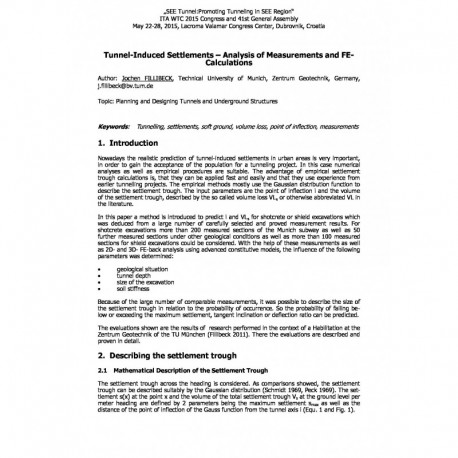Cart
0
0
No document
0,00 €
Total
Document successfully added to your shopping cart
Quantity
Total
There are 0 items in your cart.
There is 1 item in your cart.
Total documents
Total shipping
To be determined
Total
Search & filter
Search for a publication
Search & filter

Tunnel-Induced Settlements – Analysis of Measurements and FE Calculations
wtc2015_full_fillibeck-1
Nowadays the realistic prediction of tunnel-induced settlements in urban areas is very important, in order to gain the acceptance of the population for a tunneling project. In this case numerical analyses as well as empirical procedures are suitable. The advantage of empirical settlement trough calculations is, that they can be applied fast and easily and that they use experience from earlier tunnelling projects. The empirical methods mostly use the Gaussian distribution function to describe the settlement trough. The input parameters are the point of inflection i and the volume of the settlement trough, described by the so called volume loss VL or otherwise abbreviated VL in the literature. In this paper a method is introduced to predict i and VL for shotcrete or shield excavations which was deduced from a large number of carefully selected and proved measurement results. For shotcrete excavations more than 200 measured sections of the Munich subway as well as 50 further measured sections under other geological conditions as well as more than 100 measured sections for shield excavations could be considered. With the help of these measurements as well as 2D- and 3D- FE-back analysis using advanced constitutive models, the influence of the following parameters was determined: • geological situation • tunnel depth • size of the excavation • soil stiffness Because of the large number of comparable measurements, it was possible to describe the size of the settlement trough in relation to the probability of occurrence. So the probability of falling be-low or exceeding the maximum settlement, tangent inclination or deflection ratio can be predicted. The evaluations shown are the results of research performed in the context of a Habilitation at the Zentrum Geotechnik of the TU München (Fillibeck 2011). There the evaluations are described and proven in detail.



